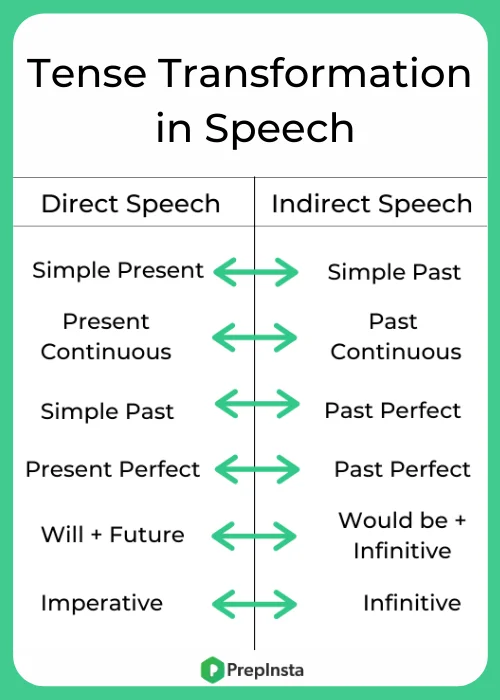Tips And Tricks And Shortcuts For Speech & Voices
Tips and Tricks and Shortcuts For Speech and Voices
Speech and voice skills are considered to be a good parameter in English language. If you can use passive voice properly, you will be considered to have a good command on English. To solve speech and voice questions you must have considerable knowledge of grammar and general rules to solve the exercises. So here are some Tips and Tricks and Shortcuts for speech & voices –
To learn and to clarify speech and voice are divided into 2 main parts
1.Active Voice 1. Direct Speech
2.Passive Voice 2. Indirect Speech

Tips and Tricks and Shortcuts for Speech Translation
Tips to convert Direct into Indirect Speech.
Tip 1:
When a reporting verb in the direct speech sentence is in past tense, then while converting it to indirect speech, all present tense transforms to past tense.
- For Example:
Direct: He said ” I am playing guitar”
Indirect: He said (+ that) he was playing guitar.
Tip 2:
Changing from Present to Past
- Simple Present Changes to Simple Past
- Present Perfect Changes to Past Perfect.
- Present Continuous Changes to Past Continuous
- Present Perfect Changes to Past Perfect
Tip 3:
Changing Past and Future Tense
- Simple Past Changes to Past Perfect
- Past Continuous Changes to Past Perfect Continuous
- Future Changes to Present Conditional
- Future Continuous Changes to Conditional Continuous
Tip 4:
- If a sentence begins with (what, where, when) as an interrogative sentence, then we do not use any conjunction (that).
- If a direct speech sentence begins with an auxiliary verb/helping verb, it takes the form of if / whether in the indirect clause.
- Reporting verbs in direct speech change to asked, enquired, demanded in indirect speech.
Tip 5:
In the process of translating direct to indirect speech, the modals change too:
- Can changes to could
- May changes to might
- Must changes to had to /would have to
However the modals that do not change their forms are – Could, Would, Should, Might, Ought to
Tip 6:
Changes in degree of person.
First Person – I, Me, Myself, Mine, Our, Ours, We, Ourselves
Second Person – You, Your, Yourself, Yours.
Third Person – She, Her, Hers, Herself, He, Him, His, Himself, They, Them, Themselves, Their, Theirs,
- First person changes as per the subject:
- The second person changes as per the object of reporting speech.
- The third person remains unchanged.
Tip 7:
Changing the form of sentence.
In Indirect Speech we use some supportive verbs like requested, ordered, suggested and advised. We use forbid/forbade in negative sentences. Thus, the imperative in direct speech changes to infinitive (to) in indirect speech.
In Exclamatory sentences we remove the interjections (alas, oh, hurrah, bravo……) and change the sentence to assertive.
Tip 8:
Changes in Time, place or thing.
In direct speech words that objectify nearness will translate to distance verbs in indirect speech.
- Now becomes then
- Today becomes that day
- Tomorrow becomes the next day
- This becomes that
- Yesterday becomes the day before / the last day
- These become those
- Next week or month becomes following week/month
Rules of converting Indirect Speech into Direct Speech
The rules that we follow to convert from indirect speech to direct speech are mentioned below:
- Reporting verbs should be used correctly – say, said, told.
- There should be comma before the statement followed by inverted quotes (“”) and the first letter should be capital.
- Use questions mark, exclamation mark, quotations in the right place.
- Remove unnecessary conjunctions (that, if, whether)
- The reporting verb shod be changes from past to present when converting from indirect to direct.
- Past perfect tense should be changed to simple past or present perfect as needed.
Prime Course Trailer
Related Banners
Get PrepInsta Prime & get Access to all 200+ courses offered by PrepInsta in One Subscription
Tips and Tricks for Voice Translation
Tips to Convert Active To Passive Voice:
Tip 1:
Interchange the subject and the object places. While doing alteration in the sentences the subject should become the object and the object should become the subject.
Tip 2:
While making the changes in the sentences by default alter the main verb into the third form. let’s understand the same with the help of a few examples:
[table id=964 /]
Tip 3:
Whenever making a passive sentence, use the word “by” previously to the subject. For instance:
- Active voice: Anjana sang a song.
- Passive voice: A song was sung by Anjana.
Tip 4:
Change in the auxiliary word tense: As we see in the above examples, there is a change in the verb forms, now here will be a change in the auxiliary word tense also. Let’s understand with the below examples:
- Present tense–
Active voice: Sun sets to the west.
Passive voice: West is where the sun sets. - Past tense–
Active voice: Yami walked my pet home.
Passive voice: My pet was walked home by Yami. - Future tense–
Active voice: Akshara will do the thread work.
Passive voice: Thread work will be done by Akshara.
Tip 5:
In few sentences you need to make a judgement call. If there are some passive voice sentences you need to fully overlook the subject if the message is clear.
For example:
- Active voice: Weight is measured in kilograms.
- Passive voice: Kilogram is a measurement unit for weight.
Tip 6:
In passive voice few words are used often such as “with” or “to”. However use of “by” is quite frequent than other words.
- Active voice: I know my son’s principal.
- Passive voice: My son’s principal is known to me.
- Active voice: True friendship fills her heart.
- Passive voice: Her heart is filled with true friendship.
Here are some Sample Questions along with Tips and Tricks and Shortcuts for Speech and Voices
Sample Questions for Speech and Voice Translation
Tips and Tricks 1:- Direct Speech
It is written text or spoken language in which speech or language will be in its original form expressed by the main speaker or writer.
Question 1.
In the following question sentence is given in Direct / Indirect speech. Out of the given options select that option which expresses the same sentence in Indirect /Direct speech.
Sudhakar said, “All people have equal rights.”
A. Sudhakar said that all people had equal rights.
B. Sudhakar said that all people have equal rights
C. Sudhakar asked that all people have equal rights?
D. Sudhakar said that all people has equal rights
Answer: option B
Explanation: option B is the exact indirect speech of the question. The words have changed and ‘that’ is used correctly before the spoken words of the speaker.
Tips and Tricks 2:- Indirect Speech:
It is a form of expressing the written text or spoken language in an indirect but implicit way. It means that it is not as same as expressed by the original speaker or writer.
For example: He says, “I am ill “is direct speech, and whereas He says that he is ill is an indirect speech. Or you may remove that from the sentence and make it as: “he says he is ill”.
Question 2.
In the following question sentence is given in Direct / Indirect speech. Out of the given options select that option which expresses the same sentence in Indirect /Direct speech.
Dhara said that she might meet Naidu there
A. Dhara said that she may meet Naidu here.
B. Dhara said, “she may meet Naidu here”.
C. Dhara said, “I may meet Naidu here”.
D. Dhara said that I may meet Naidu here
Answer: option C
Explanation: option C makes correct direct speech sentence of the question. The words have changed and ‘that’ is removed before the spoken words of the speaker.
Tips and Tricks 1:- Active Voice:
When the subject performs the action stated by the verb in the sentence, it is known as active voice. Sentences in the active voice are simple as the main focus is on the subject.
Formula for Active voice: Subject + Verb + Object
Question 1.
change the following sentence into the passive voice
Sam will have taken the exam.
A. The exam will have been taken by Sam
B. The exam will be taken by Sam
C. Sam will have been taken the exam
D. None of the above
Answer: option A
Explanation: As per formula first object will come then verb and then subject. Hence here the object is exam, taken is verb and sam is subject. So the correct sentence will be: The exam will have been taken by Sam.
Tips and Tricks 2:- Passive Voice:
If the subject performed upon the verb, then it is known as passive voice. In this the main emphasis is on the action and not on the one who is doing it i.e. subject. Sentences in the passive voice are complex as the focus is on the actions.
Formula for Passive voice: Object + Verb + Subject
Question 2.
Change the following sentence into the active voice
Specialists should be hired by them
A. They should hire specialists.
B. Hiring of specialist should be done by them
C. Specialist should be hired
D. None of the above
Answer: option A
Explanation: As per rules subject should come first then verb and then object. Option A follows the rule correctly.
Also Check Out
Get over 200+ course One Subscription
Courses like AI/ML, Cloud Computing, Ethical Hacking, C, C++, Java, Python, DSA (All Languages), Competitive Coding (All Languages), TCS, Infosys, Wipro, Amazon, DBMS, SQL and others
- Basic Grammar – Questions | Rules | How to Solve Quickly | Tricks & Shortcuts
- Tenses – Questions | Rules | How to Solve Quickly | Tricks & Shortcuts
- Articles – Questions | Rules | How to Solve Quickly | Tricks & Shortcuts
- Tenses and Articles – Questions | Rules | How to Solve Quickly | Tricks & Shortcuts
- Idioms and Phrases – Questions | Rules | How to Solve Quickly | Tricks & Shortcuts
- Subject Verb Agreement – Questions | Rules | How to Solve Quickly | Tricks & Shortcuts
- Prepositions and Conjunction – Questions | Rules | How to Solve Quickly | Tricks & Shortcuts
- Selecting Words – Questions | Rules | How to Solve Quickly | Tricks & Shortcuts
- Relative Pronoun – Questions | Rules | How to Solve Quickly | Tricks & Shortcuts
- Sentence Completion- Questions | Rules | How to Solve Quickly | Tricks & Shortcuts
- Basic Grammar – Questions |
Rules |
How to Solve Quickly |
Tricks & Shortcuts - Tenses – Questions |
Rules |
How to Solve Quickly |
Tricks & Shortcuts - Articles – Questions |
Rules |
How to Solve Quickly |
Tricks & Shortcuts - Tenses and Articles – Questions |
Rules |
How to Solve Quickly |
Tricks & Shortcuts - Idioms and Phrases – Questions |
Rules |
How to Solve Quickly |
Tricks & Shortcuts - Subject Verb Agreement –
Questions |
Rules |
How to Solve Quickly |
Tricks & Shortcuts - Prepositions and Conjunction – Questions |
Rules |
How to Solve Quickly |
Tricks & Shortcuts - Selecting Words – Questions |
Rules |
How to Solve Quickly |
Tricks & Shortcuts - Relative Pronoun – Questions |
Rules |
How to Solve Quickly |
Tricks & Shortcuts - Sentence Completion- Questions |
Rules |
How to Solve Quickly |
Tricks & Shortcuts






Easy trick to solve coding